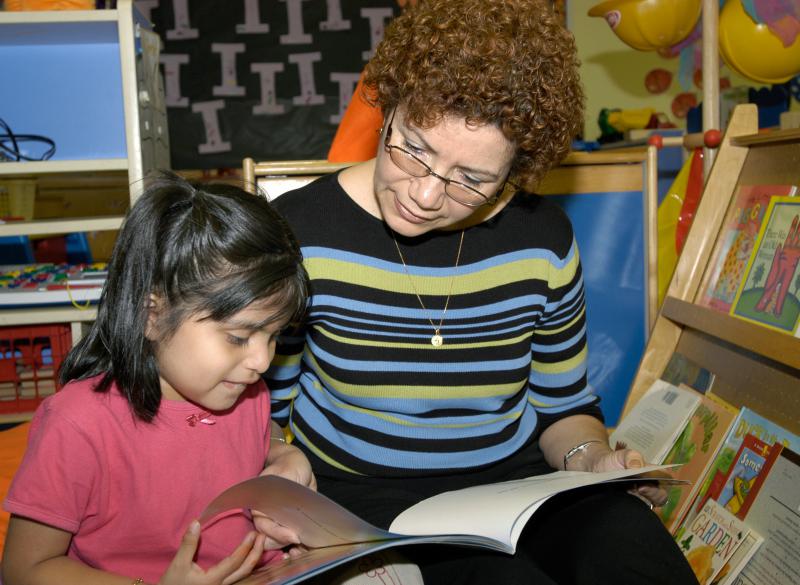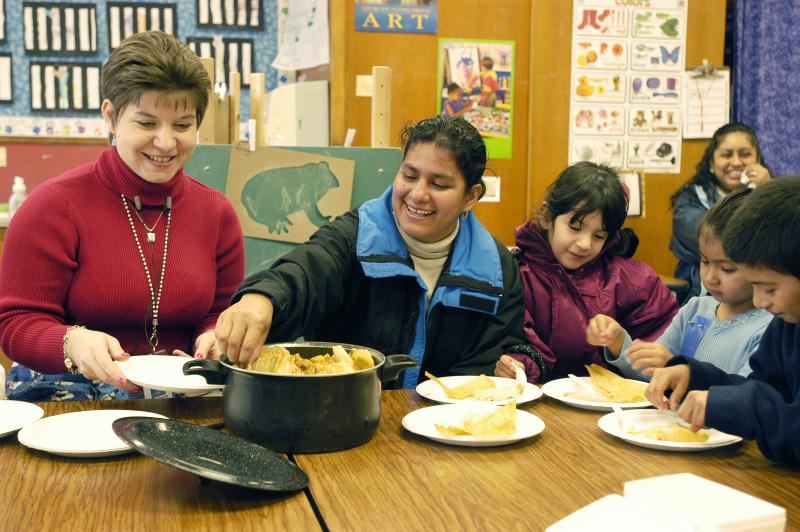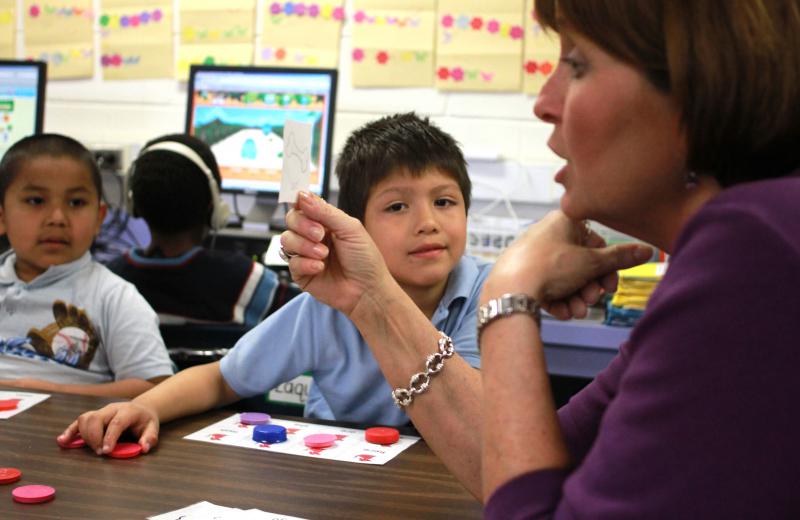Promoting Vocabulary Development in Young English Learners
 by Dr. Cristina Gillanders (© FirstSchool 2014)
by Dr. Cristina Gillanders (© FirstSchool 2014)
This practitioner-focused resource contains research-based guidance for educators who want to actively promote vocabulary development in young ELL children. Please click below to access each section, or scroll down to access the resource in full:
Teaching Vocabulary Throughout the Day
Promoting Vocabulary Through Conversations and Discussions
 Understanding and using words plays a critical role in children’s success in school. Every day in classrooms, teachers communicate knowledge and skills through oral and written language, and children demonstrate what they know through words. Research on English-speaking monolingual children suggests that vocabulary development in the early school years has an important impact on children’s reading comprehension in later years (Lonigan & Shanahan, 2009). Similarly, for English learners, both Spanish and English vocabulary in preschool have been found to be related to word reading skills in English in first and later grades (Rinaldi & Páez, 2008; Kieffer, 2012; Mancilla-Martinez & Lesaux, 2010).
Understanding and using words plays a critical role in children’s success in school. Every day in classrooms, teachers communicate knowledge and skills through oral and written language, and children demonstrate what they know through words. Research on English-speaking monolingual children suggests that vocabulary development in the early school years has an important impact on children’s reading comprehension in later years (Lonigan & Shanahan, 2009). Similarly, for English learners, both Spanish and English vocabulary in preschool have been found to be related to word reading skills in English in first and later grades (Rinaldi & Páez, 2008; Kieffer, 2012; Mancilla-Martinez & Lesaux, 2010).
Many English learners do not develop the vocabulary that helps them to succeed in school. In 2011, in 4th grade, only 31% of English learners performed at or above the basic level of reading achievement (National Assessment of Educational Progress, 2012). As English learners grow older, lack of knowledge of both frequently and infrequently used words hinders their ability to comprehend text in school, and in turn limits their opportunities to learn new words through reading (Carlo, August, McLaughlin, Snow, Dressler, Lippman, ... & White, 2004). The good news is that given the appropriate instruction, English learners are able to catch up to their monolingual counterparts with the added advantage of knowing words in two languages (Hammer, Lawrence, & Miccio, 2008). Silverman (2007) found that a group of English learners in kindergarten were able to learn new words as easily and even faster than a group of English monolingual children when provided vocabulary instruction that included reading aloud and using multiple methods for learning new words. This kind of success makes it crucial to provide systematic and effective vocabulary instruction to English learners as early as possible.
FirstSchool is focused on improving the school experiences of African American, Latino and low income children. Many of the Latino children in the schools we work with are English learners. The purpose of this brief is to provide some guidelines and resources for teaching vocabulary to young English learners.
When teaching vocabulary to young English learners, consider the following:
- Provide multiple opportunities for children to listen and use words in a variety of contexts: Children need to hear and use words multiple times in order to learn their meaning. Some researchers have indicated that in order to learn a new word, children need to have somewhere between seven and twelve opportunities to listen and use the word in a meaningful context (Stahl, 1986; Nagy, 2005). Teachers can intentionally create a variety of opportunities for using words so that children can understand their different connotations.
- Expose English learners to a combination of direct teaching and exposure of words in everyday routines. English learners can learn words as they interact with peers and adults in the classroom. However, they also need teachers or adults to directly teach them the meaning of words. In the busy life of a classroom, it is important to set up specific times for direct instruction that supports the learning of particular words (Biemeller & Boote, 2006).
- Take advantage of knowledge of the word in the first language: Multiple studies have shown the importance of using English learners’ first language to improve children’s learning (e.g Bartlett et. al, 2007; Burchinal, Field, López, Howes, & Pianta, 2012). Teachers can use the children’s first language to help them understand and use new words in English. For example, children might know some words in their first language that are cognates, or words that share a similar spelling, meaning and pronunciation across languages (e.g. familia/family, clase/class, delicioso/delicious).
- Take into consideration that English learners come to the classroom with different levels of English proficiency. Some children have been exposed to both English and their home language since birth, while others encounter English for the first time when they begin school. Depending on children’s proficiency in English, teachers will need to use different strategies to scaffold children’s understanding and learning of new words.
-
 Make explicit connections to children’s sociocultural experiences at home and in their community. Children learn new words when they can connect them to their background knowledge and experiences. Teachers’ knowledge of English learners experiences at home and their community is critical to helping children make these connections (see FirstSchool’s resource “Exploring Families’ Beliefs and Practices” for ways in which teachers can find this information)
Make explicit connections to children’s sociocultural experiences at home and in their community. Children learn new words when they can connect them to their background knowledge and experiences. Teachers’ knowledge of English learners experiences at home and their community is critical to helping children make these connections (see FirstSchool’s resource “Exploring Families’ Beliefs and Practices” for ways in which teachers can find this information)
- Create situations in which children are actively engaged in learning a new word. As with any learning, English learners will learn new words when they are actively engaged. Even though children may not have the English proficiency to answer questions or provide long and elaborate explanations, teachers need to find ways in which children can participate in daily activities. For example, teachers can ask children to demonstrate their understanding using a gesture, drawing a picture or sharing their ideas with a friend in the first language.
Online Resources:
- Teaching English Language Learners to Read - In this webcast, researchers Dr. Diane August, Dr. Fred Genese and Dr. Margarita Calderon discussed different issues related to teaching literacy instruction to ELLs including the importance of vocabulary learning. (http://www.colorincolorado.org/webcasts/teaching/)
- Using Cognates to Develop Comprehension in English - http://www.colorincolorado.org/educators/background/cognates/
Articles:
- Goldenberg, C., Hicks, J., & Lit, I. (2013). Dual Language Learners. American Educator, 37(2), 27.
- Manyak, P. C., & Bauer, E. B. (2009). English vocabulary instruction for English learners. The Reading Teacher, 63(2), 174-176.
Activity:
Audio or videotape yourself while you are engaged in a large or small group activity in your classroom. Observe how you use language:
- Pay attention to the amount of time you and the children spend talking. Who spends more time talking? You or the children?
- Count the number of different words you use.
- Examine the variety of words you use.
- How often do you explain words to the children in your class?
- How many times do you use the new words you have taught during the day?
- How many new words do you include when you elaborate on English learners’ talk?
- Do you use the English learners’ first language? When do you use it most often?
- How often do you engage English Learners in conversation?
 Storybook reading has been widely recommended for promoting vocabulary acquisition in young children. By listening to stories, children learn new words they will likely encounter in texts as they become readers. A storybook reading session will be effective only when children remain active listeners and when they can participate during the reading of the story. For young English learners, this might be a challenge. To become an active listener, children need to understand at least some of the story. For English learners who are in the beginning stages of English language acquisition, it might be difficult to understand and participate. Therefore, teachers need to maximize the opportunities for children to understand the text and to plan for opportunities for children to participate considering their level of English proficiency. When reading aloud, consider the following:
Storybook reading has been widely recommended for promoting vocabulary acquisition in young children. By listening to stories, children learn new words they will likely encounter in texts as they become readers. A storybook reading session will be effective only when children remain active listeners and when they can participate during the reading of the story. For young English learners, this might be a challenge. To become an active listener, children need to understand at least some of the story. For English learners who are in the beginning stages of English language acquisition, it might be difficult to understand and participate. Therefore, teachers need to maximize the opportunities for children to understand the text and to plan for opportunities for children to participate considering their level of English proficiency. When reading aloud, consider the following:
- Introduce the book. Spark children’s interest and understanding of the book by giving opportunities to see the pictures in the book and to predict what the book might be about.
- Select a limited number of words to focus on (3 to 5 words).
- Use the children’s first language strategically. Comprehension of the content will be greatly enhanced if children can listen to the read aloud first in their first language and then on a separate occasion in English. Parents can also be an important resource for reading the book in the first language at home or in the classroom, and for translating the text in those cases when the book has been written in English and there is no available translation in the first language. Teachers can also find the translation of the core vocabulary words so that they can use them during the read aloud or to point out the similarity of the word in English and Spanish in case that the word is a cognate (see online resource above).
- Use gestures, pictures and realia (objects from real life) to illustrate meaning of the words and phrases.
- Read the story several times during the week.
- Incorporate culturally relevant thematic units and books. Learning a word does not occur in isolation, but rather happens when children can make connections between the meaning of the word and their prior experiences. Children who come from minority backgrounds often find that the experiences in school are different from their experiences at home and in their community. Therefore, using books that reflect in some way upon children’s sociocultural experiences can facilitate their learning of new words (see below for a list of recommended books).
- Consider children’s level of second language acquisition. When teachers read a story in English, English learners will understand and participate differently depending on their English proficiency. Those who are in early stages of English acquisition might comprehend teachers’ questions but might answer in Spanish, while others who are more advanced might be able to participate by providing full sentences. Teachers should plan for different opportunities for participation (e.g. pointing to pictures, making a gesture connected to the story, repeating a common phrase, etc.), so children continue to be engaged.
- Encourage children to retell and/or to dramatize the story so that they can use the new words in the context of the story’s narrative.
- Expand the ideas in the book to other centers or learning stations. Teachers can prepare learning centers with materials and activities so that children have other opportunities to use the words learned during the read aloud in a different context.
Activity and Video Resource:
The online video below shows 1st grade teacher Ali Nava conducting a read- aloud session of the book “Burro’s Tortillas” by Terri Fields, which is a Southwestern version of the folk tale “The Little Red Hen”. In the video, identify the considerations described above for reading aloud to young ELLs.
Common Core Lesson Plans for ELLs:
http://www.colorincolorado.org/common-core/classroom/lessons/
Articles:
- Gillanders, C., & Castro, D. (2011) Storybook Reading for young Dual Language Learners. Young Children, 66(1), 91-95
- Hickman, P., Pollard-Durodola, S. & Vaughan, S. (2004) Storybook reading: Improving vocabulary and comprehension for English-language learners. The Reading Teacher, 57(8), 720-730
Book:
- Hickman, P. & Pollard-Durodola, S. D. (2009). Dynamic read-aloud strategies for English learners : building language and literacy in the primary grades. Newark, DE: International Reading Association.
 Activity - Your Turn:
Activity - Your Turn:
Taking into consideration the recommendations given above, plan a read-aloud session with your colleagues. Subsequently, implement your plan and videotape one or all the read-aloud sessions. Review the video with colleagues and discuss your successes and challenges.
- Choose a book to read.(Below you can find a list of recommended books in English and Spanish.)
-
Plan your read-aloud:
- How will you activate children’s background knowledge to help them learn new words?
- When and how will you present the book in the child’s first language?
- How will children participate in the reading of the book?
- When and how will the core words be presented?
- What kinds of extended activities will you plan to maximize children’s understanding and use of the core words in different contexts?
-
Select three core words to emphasize and directly teach. Consider the following:
- Is this word important for understanding the story?
- Can the word be demonstrated in a gesture or be represented with an object or picture?
- Is this a word that frequently appears in texts and will help children understand other stories?
- Is there a variety of types of words (i.e. nouns, verbs, adjectives, adverbs)?
- How does this word relate to children’s experiences?
- What is the translation of this word in English or Spanish?
-
Plan the teaching of these words
- What is a child-friendly definition for each of the words?
- What questions can you ask children to help them relate the word to past experiences?
- How will you consider the children’s level of second language acquisition when asking these questions?
- What object can you use to represent the word?
- How will you know if the children already know and understand this word?
Lists of Recommended Books for English Learners:
http://www.colorincolorado.org/read/forkids/
FirstSchool’s List of Recommended Books for Spanish-English Bilinguals:
Fairy Tales, Folk Tales and Fables -
- Ada, A. F. (1993) La tataranieta de cucarachita Martina. New York: Scholastic
- Gonzalez, L. (1994) The bossy gallito/ El Gallo de Bodas: A traditional Cuban folktale. New York: Scholastic
- Moreton, D. (1997) La cucaracha Martina: A Caribbean Folktale. New York: Turtle Books [Available in Spanish: La cucaracha Martina: Un cuento folklórico del Caribe]
Books in Spanish and Dual Language Books -
- Ada, A. (1997) Mediopollito/Half-Chicken. New York: Bantam Doubleday.
- Ada, A. F. (1995) My Name Is Maria Isabel.
- Bertrand, D. G. (1997) Sip, slurp, soup, soup/Caldo, caldo, caldo. Houston: Piñata Books
- Bertrand, D. G. (2010) The party for Papá Luis/ La fiesta para papá Luis. Houston, TX: Piñata Books
- Bertrand, D.G. (2003) Las empanadas that Abuela made/Las empanadas que hacía la Abuela. Houston: Piñata Books
- Cisneros, S. (1994) Hairs. Pelitos. New York, NY: Dragonfly Books
- Cumpiano, I. (2005) Quinito’s Neighborhood. El Vecindario de Quinito. California: Children’s Book Press
- Laínez, R. C. (2010) The tooth fairy meets el ratón Pérez. New York, NY: Random House
- Laínez, R. C.(2009) René has two last names/ René tiene dos apellidos. China: Piñata Books
- Lofane (2001) Translation Gladys Rosa-Mendoza. Lola, ma+me publishing, inc.
- Martínez, A. C. (1991) The woman who outshone the sun/ La mujer que brillaba aún más que el sol. New York, NY: Lee & Low Books Inc.
- Mora, P. (2009) Book Fiesta! New York, NY: HarperCollins Publishers
- Reiser, L. (1993) Margaret and Margarita/ Margarita y Margaret. Greenwillow: Harper Collins
- Reiser, L. (2007) My Way/ A mi manera. Greenwillow: Harper Collins
- Soto, G. (1993) ¡Qué montón de tamales! New York: Scholastic [Available in English: Too many tamales! New York: Putman]
- Williams, V.B. (1984) A chair for my mother. New York: HarperTrophy [Available in Spanish: Un sillón para mi mamá. New York: Rayo]
Teaching Vocabulary Throughout the Day
Learning new words can happen at many other times as well. Read-alouds occupy only a small part of the school day, so enhancing other activities for promoting vocabulary is critical for the development of English learners. This means that teachers need to be aware of English learners’ vocabulary understanding and integrate it across all content areas. In the video clip below, you can see a third grade teacher checking for understanding of the meaning of a word in a mathematics problem.
Note that in the video the teacher gives an explanation of the word “vase” which was part of a mathematical word problem. She uses an event that happened in the classroom as a reference or context to explain the meaning of the word (“Do you remember when [name of child] brought those roses, and we had those roses in the back in that tall glass container [makes gesture]? That is a vase.”).
Promoting Vocabulary Through Conversations and Discussions
 Set up a time in the day to have conversations with children one-to-one. During conversations with adults and peers, English learners have the opportunity to learn new words and practice those which have been recently acquired. Therefore, it is important to plan for opportunities for English learners to have conversations with English-speaking adults and peers. Some of those opportunities could be during mealtimes, as children arrive at school, and while children are working independently in centers or stations.
Set up a time in the day to have conversations with children one-to-one. During conversations with adults and peers, English learners have the opportunity to learn new words and practice those which have been recently acquired. Therefore, it is important to plan for opportunities for English learners to have conversations with English-speaking adults and peers. Some of those opportunities could be during mealtimes, as children arrive at school, and while children are working independently in centers or stations.
Resource:
- Bond, M. A., & Wasik, B. A. (2009). Conversation stations: Promoting language development in young children. Early Childhood Education Journal, 36(6), 467-473.
Discussions in small groups:
Teachers can plan to conduct small group discussions in which English learners can listen and use academic language. Rather than engaging English learners in “known-answer” questions, teachers create an environment in which English learners can exchange ideas and discuss interesting topics. “Instructional Conversations” have been used with older English learners and describe dynamic exchanges between teachers and students in a specific topic. Goldenberg (1992) has identified the following elements of “instructional conversations” that we have adapted here for younger learners.
 Elements of Instructional Conversations:
Elements of Instructional Conversations:
(adapted from Goldenberg, 1992)
Instructional Elements
- Thematic focus: The teacher selects a topic or theme that could emerge from children’s interests or curriculum, and plans for how the topic will be developed during the conversation.
- Activation and use of children’s background knowledge: The teacher explores if the children have the necessary background knowledge to participate in the discussion and refers to prior experiences as starting points in the discussion.
- Direct teaching: The teacher provides direct teaching of a word or concept providing child-friendly definitions and illustrating the word with a picture, realia or gesture.
- Promotion of more complex language: The teacher uses statements to promote more extended children’s language (e.g. Tell me more; What do you mean?)
- Elicitation of metacognition: The teacher encourages children to describe their thinking process to come up with their statements (e.g. How do you know? What made you think that?)
Conversational Elements
- Fewer “known-answer” questions: The teacher encourages discussion through questions that have multiple answers.
- Responsiveness to children’s participation: The teacher follows the children’s lead while at the same time maintaining the focus on the topic of discussion.
- Connected discourse: The teacher encourages exchanges that build on each other’s comments to keep the conversation flowing.
- A non-threatening atmosphere: English learners feel comfortable taking the risk of participating presenting their ideas. There is a sense of collaboration rather than competiveness.
- General participation: All children are included. English learners feel they can participate in English and their first language.
English learners will need teachers to use scaffolding strategies such as pictures and props to help English learners understand the topics of discussion. Also, children will be better able to discuss a topic that is familiar to them.
Articles:
- Goldenberg, C. (1992). Instructional conversations: Promoting comprehension through discussion. The Reading Teacher, 46(4), 316-326.
Resources:
- More on Instructional Conversations - http://crede.berkeley.edu/research/crede/instruc_conv.html
Suggested citation for this resource (© FirstSchool 2014):
Gillanders, C. (2014). Promoting vocabulary development in young English learners. Chapel Hill, NC: FirstSchool.


